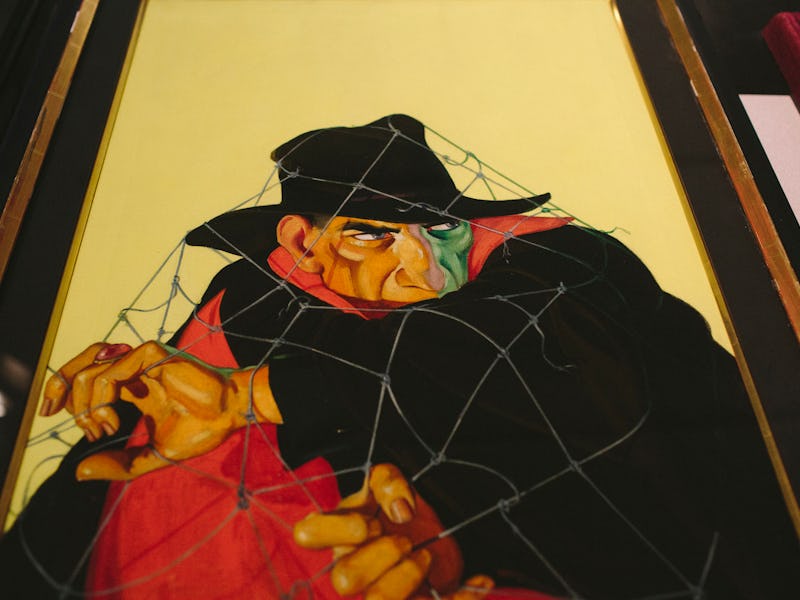A Pulpy Hero Inspired Batman — And Caped Crusader (Kind of) Brought Him Back
Do you know what the Shadow knows?

Batman is moody. This may be the greatest understatement about a superhero ever, but not only is Batman as a character a moody person, but his aesthetic origins are also full of melancholic imagery and spookiness. Part of this is because Batman wasn’t a wholly original creation. While the first iteration of Batman appeared in Detective Comics #27 in 1939 and was created by Bob Kane and Bill Finger, Batman’s direct precursor was floating around nine years earlier. A pulp vigilante known as the Shadow hit the radio waves in 1930, and then starred in his own magazine starting in 1931. Make no mistake, the Shadow is Batman’s direct pop culture parent. And in the new Prime Video series, Batman: Caped Crusader, a direct reference to this inspiration is made very, very clear. Mild spoilers ahead.
In the second episode of Batman: Caped Crusader, “...And Be a Villain” we get a retelling of the origin story for the villain known as Clayface. Because Batman: Caped Crusader is set in a kind of anachronistic version of the 1950s or ‘60s, characters use rotary phones, and the movie seem to still be made exclusively in black-and-white.
Produced by Bruce Timm — who gave the world Batman: The Animated Series in 1992 — there’s a certain argument that the entirety of Caped Crusader should be in black-and-white, too. The opening titles are black-and-white, and the faux-retro aesthetic pervades every aspect of the series. Alfred does not yet have grey hair in this early, alternate incarnation of Gotham City, and Batman’s general visage is very close to how he appeared in the “Golden Age” of DC Comics.
The apotheosis of this throwback vibe is made completely clear in “...And Be a Villain” because of the fact that much of the mystery of the episode takes place on or near a movie set. We learn that Boris Karlo (soon to be Clayface) has made a career as an actor in certain kinds of horror movies in which he has played the “heavy.” Visually, the episode does a lot of work to make Karlo’s movies seem like a cross between Universal’s classic monster movies, and the horror films produced by Hammer.
This version of Karlo is a bit of a reboot of the Golden Age version of Clayface, simply because in Caped Crusader, Clayface isn’t a full-on sci-fi shapeshifter, but rather the victim of some extreme reconstructive surgery. While utterly horrifying, this Clayface is oddly more down-to-earth in contrast with the version we’re most familiar with. During Karlo’s clashes with Batman in this episode, there are also several big references to a bygone era of adventure, including a big sword fight near the end, in which Batman and Clayface duel on the staircase of a castle. This is a direct reference to the Errol Flynn versus Basil Rathbone sword fight from the 1938 version of Robin Hood, a hit movie in theaters one year before Batman made his comic book debut. (This exact sword fight has been homaged many times, including Highlander and Star Trek: The Next Generation.)
Clayface...or the Shadow?
But the most overt homage to a pulpy past is the fact that in several scenes in this episode, Karlo dresses exactly like the pulp hero, the Shadow. He’s rocking a big black hat, and red scarf covering the lower half of his face, just as the Shadow was depicted ever since 1931. Created by Walter B. Gibson, the Shadow began life as a narrator of a radio show and then became a magazine character published by Street & Smith. (This publisher was also responsible for the most important pulp sci-fi magazine ever, Astounding.) In comic/magazine form, the Shadow was a dark vigilante who possessed powers of hypnotism and pseudo-telepathy. His catchphrase was, “Who knows what evil lurks in the hearts of men? The Shadow knows!”
One glance at the Shadow makes it clear he was a huge influence on Batman. Gibson even called Batman a “clowned up” version of the Shadow at one point. Batman and the Shadow eventually crossed over a few times in DC Comics, but there’s a good chance that most contemporary Bat-fans have close to zero knowledge of this character. And, even though it happened around the same time as Bruce Timm’s beloved Batman: The Animated Series, the 1994 movie The Shadow, starring Alec Baldwin in the title role, did not go over well, and has been largely forgotten.
And yet Batman owes a lot to the cape, hat, and scarf of the Shadow. By putting a villain in the garb of the Shadow, Caped Crusader nods towards Batman’s shadowy past with more than a wink. The Shadow was always more violent and murderous than Batman. And in Caped Crusader, we’re briefly reminded of the idea that Batman himself is always on the precipice of going too far into the dark.